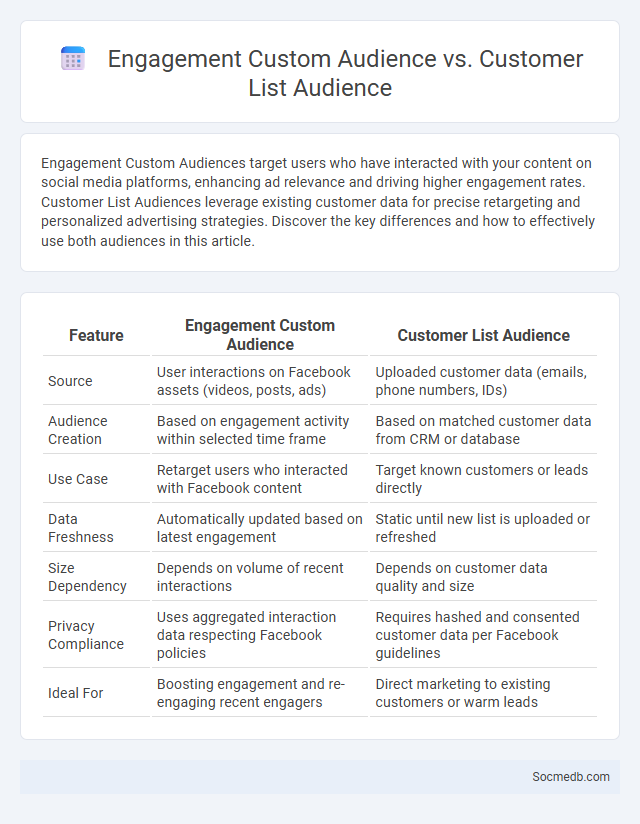
Photo illustration: Engagement Custom Audience vs Customer List Audience
Engagement Custom Audiences target users who have interacted with your content on social media platforms, enhancing ad relevance and driving higher engagement rates. Customer List Audiences leverage existing customer data for precise retargeting and personalized advertising strategies. Discover the key differences and how to effectively use both audiences in this article.
Table of Comparison
| Feature | Engagement Custom Audience | Customer List Audience |
|---|---|---|
| Source | User interactions on Facebook assets (videos, posts, ads) | Uploaded customer data (emails, phone numbers, IDs) |
| Audience Creation | Based on engagement activity within selected time frame | Based on matched customer data from CRM or database |
| Use Case | Retarget users who interacted with Facebook content | Target known customers or leads directly |
| Data Freshness | Automatically updated based on latest engagement | Static until new list is uploaded or refreshed |
| Size Dependency | Depends on volume of recent interactions | Depends on customer data quality and size |
| Privacy Compliance | Uses aggregated interaction data respecting Facebook policies | Requires hashed and consented customer data per Facebook guidelines |
| Ideal For | Boosting engagement and re-engaging recent engagers | Direct marketing to existing customers or warm leads |
Introduction to Audience Types in Digital Marketing
Understanding audience types in digital marketing is crucial for effective social media strategies, encompassing demographics such as age, gender, location, and interests. Segmentation into categories like prospects, customers, and brand advocates allows tailored content that drives engagement and conversion. Leveraging data analytics tools enhances precision in targeting these audience segments, optimizing campaign performance across platforms like Facebook, Instagram, and LinkedIn.
Understanding Engagement Custom Audiences
Understanding Engagement Custom Audiences allows you to target users who have interacted with your social media content, maximizing ad relevance and campaign effectiveness. These audiences include people who watched your videos, clicked links, filled out lead forms, or engaged with your posts, providing rich behavioral insights. By leveraging Engagement Custom Audiences, your marketing strategy can deliver personalized ads that boost conversion rates and improve ROI.
Exploring Customer List Audiences
Exploring Customer List Audiences on social media allows you to leverage your existing customer data for highly targeted ad campaigns, increasing engagement and conversion rates. By uploading your customer email lists, phone numbers, or user IDs, social platforms like Facebook and Instagram create custom audiences that match your ideal buyer profiles. This strategy maximizes ROI by reaching users with personalized messages based on their previous interactions with your brand.
Defining the Target Audience
Defining the target audience in social media marketing involves identifying specific demographic, psychographic, and behavioral characteristics that influence content engagement and conversion rates. Detailed audience segmentation based on age, gender, location, interests, and online behavior enhances the precision of targeted campaigns. Employing tools like Facebook Audience Insights and Google Analytics enables data-driven strategies to reach and engage the most relevant users effectively.
Key Differences Between Engagement Custom and Customer List Audiences
Engagement Custom Audiences target users who have interacted with your content on social media platforms, such as video views, post likes, or comments, enabling precise remarketing based on specific engagement behaviors. Customer List Audiences, on the other hand, utilize uploaded datasets like email addresses or phone numbers to directly connect with known customers or leads, facilitating highly personalized advertising campaigns. These audience types differ fundamentally in data sourcing, with Engagement Custom Audiences relying on platform interaction metrics and Customer List Audiences leveraging offline customer data for retargeting and lookalike modeling.
Pros and Cons of Each Audience Type
Social media audiences vary widely, each presenting unique advantages and challenges for Your engagement strategy. Younger users, often digital natives, drive trends and high interactivity but may have shorter attention spans and less brand loyalty. Older audiences typically value informative content and trustworthiness but may engage less frequently and prefer different platforms, requiring tailored approaches for maximum reach and impact.
Best Use Cases for Engagement Custom Audiences
Engagement Custom Audiences allow you to target users who have interacted with your social media content, increasing relevance and conversion rates for your campaigns. By leveraging data from video views, post reactions, comments, and page visits, you can create personalized ads that resonate with your most engaged followers. Tailoring your strategy to these high-interest audiences boosts your social media ROI and fosters deeper connections with your customers.
When to Leverage Customer List Audiences
Leverage customer list audiences on social media campaigns during product launches and sales promotions to target highly engaged users with personalized ads. Using these audiences enhances conversion rates by reconnecting with existing customers who have already shown interest. Regularly updating and segmenting customer lists ensures maximum relevance and effectiveness in retargeting efforts.
Integrating Audience Strategies for Maximum Impact
Integrating audience strategies on social media involves leveraging data analytics to identify target demographics and tailor content that resonates with their preferences and behaviors. Utilizing segmentation techniques enhances engagement by delivering personalized messages across platforms like Instagram, Facebook, and TikTok. Consistent interaction and feedback loops further optimize reach and conversion rates, maximizing the overall impact of social media campaigns.
Conclusion: Choosing the Right Audience for Your Campaign
Selecting the right audience for your social media campaign maximizes engagement and enhances return on investment by targeting users who are genuinely interested in your product or service. Leveraging data analytics and audience insights ensures your message reaches the most relevant demographics, increasing conversion rates and brand loyalty. Your campaign's success depends on precise audience segmentation, making tailored content delivery essential for meaningful connections and measurable growth.
 socmedb.com
socmedb.com